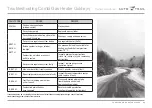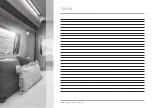
57
together we’re going places
• General comments: A flame lifting away from
the burner indicates that the pressure is too high.
A yellow flame causes sooting and indicates
the pressure is too low. If these faults occur,
recheck the regulator, cylinders and pipes,
adjust as necessary.
• Flues: Check security of fixings, attachments to
appliances and flue terminals. Check for damage
and corrosion. Check for gas leakage
into the vehicle.
• Flame failure device (FFD): Check for satisfactory
operation by the following method: after the
appliance has been checked, allow time for the
thermocouple to cool. Try to relight the appliance
by turning it on without pushing the gas control
knob in. If the appliance does not light the FFD
is working.
• Security: Check that all appliances are securely
fixed to the vehicle/ furniture and that no ‘play’
is present. Where applicable check that the
water pipes are properly attached and there
are no signs of leaks.
9. Water System
Before operating the water system, check the
following items visually for signs of leakage.
Fresh Water Tank/Container
Check condition. Fill tank and check for leaks.
Check external filler and filler pipe to tank.
Check venting. Check presence and condition
of filler cap.
Waste Water Tank
Check that the drain tap is clear and working
properly. Make sure that the drain hose is present
and in good condition.
Pump Filter
When applicable, remove filter, clean and replace.
Check the in-line pump for security of fixing and
condition. Check that the pump inlets and outlets
are clear and not obstructed. Check security of fixing
and condition of delivery hose and electric cable.
System Check
Operate the pump and check all piping for leaks.
Operate all taps and shower. If a hot water system
is fitted, it can be checked for leaks using cold water.
Please note aerated water from a tap could be
caused by a leak on the suction side of
the pump.
Waste Water System
Allow water to run through drain pipes: check for
leaks and satisfactory draining from sinks etc.
• Couplings and fluids: Avoid confusion by making
sure proper markings are used: Blue for fresh
water and red for waste water. Check that the
filler positions are correctly designated:
‘Petrol’, ‘Diesel’ and ‘Water’ as appropriate.
10. Electrical System
Extra Low Voltage 12V (Excluding vehicle electrics).
• Batteries: Check the condition of any battery
including connections, wire, fuses and relays
connected with domestic electrics.
• Wiring: Examine all visible wiring for damage
or wear. Check that all connections are safe.
• Fuses and Holders: Check that all fuses and
fuse holders protecting the domestic electrics
are satisfactory. Check that fuse ratings are
compatible with the appliances being protected.
• Appliances: Inspect all appliances for signs
of damage, overheating or wear. Check the
security of the fixings. Test the operation of
each appliance.
• Mains System 230V: Inspection and certification
of the 230V system should only be carried out
by a suitably qualified electrician.
Annual Check List
Owners Handbook :



























